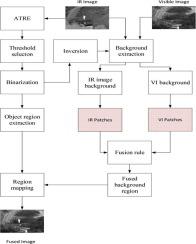Engineering Science and Technology, an International Journal ( IF 5.1 ) Pub Date : 2021-07-10 , DOI: 10.1016/j.jestch.2021.06.017 Bikash Meher 1 , Sanjay Agrawal 1 , Rutuparna Panda 1 , Lingraj Dora 2 , Ajith Abraham 3

|
In order to track a targeted environment, concealed weapon detection, navigation and military require various imaging modalities, for instance, visible image (VI) and infrared (IR) image. These modalities provide additional details. Complementary information from these images need to be fused into a single image for improved situational awareness. Hence, an ideal fused image should assimilate the essential bright information from the IR image and retain much of the original visual information from the VI. To achieve this, a region based image fusion technique using an efficient adaptive transition region extraction (ATRE) strategy is suggested in this paper. For the first time, the transition region extraction based approach is brought into the context of visible and infrared image fusion. This method is beneficial because it overcomes the problems of noise sensitivity, poor contrast and blurring effects associated with the conventional pixel-based methods. The proposed ATRE technique is used to efficiently extract the bright object regions from the IR image and retain much of the visual background regions from the VI. An adaptive parameter is introduced for accurate segmentation. A region mapping process is followed to get the fused image. Our technique is tested on standard fusion datasets. Image inspection and objective fusion indices are utilized to validate the results. They are compared with conventional and current pixel based and region based fusion techniques. The outcomes reveal that the suggested technique is comparable or better than state-of-the-art fusion techniques.
中文翻译:

使用高效自适应过渡区域提取技术的可见光和红外图像融合
为了跟踪目标环境,隐蔽武器探测、导航和军事需要各种成像方式,例如可见光(VI)和红外(IR)图像。这些方式提供了额外的细节。来自这些图像的补充信息需要融合到单个图像中,以提高态势感知能力。因此,理想的融合图像应该吸收来自 IR 图像的基本明亮信息,并保留来自 VI 的大部分原始视觉信息。为此,本文提出了一种使用高效自适应过渡区域提取 (ATRE) 策略的基于区域的图像融合技术。首次将基于过渡区域提取的方法引入可见光和红外图像融合的背景中。这种方法是有益的,因为它克服了与传统的基于像素的方法相关的噪声敏感性、对比度差和模糊效果的问题。提出的 ATRE 技术用于从 IR 图像中有效地提取明亮的物体区域,并从 VI 中保留大部分视觉背景区域。引入了自适应参数以进行准确分割。遵循区域映射过程以获得融合图像。我们的技术在标准融合数据集上进行了测试。图像检查和客观融合指数用于验证结果。它们与传统和当前基于像素和基于区域的融合技术进行了比较。结果表明,所建议的技术与最先进的融合技术相当或更好。与传统的基于像素的方法相关的较差的对比度和模糊效果。提出的 ATRE 技术用于从 IR 图像中有效地提取明亮的物体区域,并从 VI 中保留大部分视觉背景区域。引入了自适应参数以进行准确分割。遵循区域映射过程以获得融合图像。我们的技术在标准融合数据集上进行了测试。图像检查和客观融合指数用于验证结果。它们与传统和当前基于像素和基于区域的融合技术进行了比较。结果表明,所建议的技术与最先进的融合技术相当或更好。与传统的基于像素的方法相关的较差的对比度和模糊效果。提出的 ATRE 技术用于从 IR 图像中有效地提取明亮的物体区域,并从 VI 中保留大部分视觉背景区域。引入了自适应参数以进行准确分割。遵循区域映射过程以获得融合图像。我们的技术在标准融合数据集上进行了测试。图像检查和客观融合指数用于验证结果。它们与传统和当前基于像素和基于区域的融合技术进行了比较。结果表明,所建议的技术与最先进的融合技术相当或更好。提出的 ATRE 技术用于从 IR 图像中有效地提取明亮的物体区域,并从 VI 中保留大部分视觉背景区域。引入了自适应参数以进行准确分割。遵循区域映射过程以获得融合图像。我们的技术在标准融合数据集上进行了测试。图像检查和客观融合指数用于验证结果。它们与传统和当前基于像素和基于区域的融合技术进行了比较。结果表明,所建议的技术与最先进的融合技术相当或更好。提出的 ATRE 技术用于从 IR 图像中有效地提取明亮的物体区域,并从 VI 中保留大部分视觉背景区域。引入了自适应参数以进行准确分割。遵循区域映射过程以获得融合图像。我们的技术在标准融合数据集上进行了测试。图像检查和客观融合指数用于验证结果。它们与传统和当前基于像素和基于区域的融合技术进行了比较。结果表明,所建议的技术与最先进的融合技术相当或更好。我们的技术在标准融合数据集上进行了测试。图像检查和客观融合指数用于验证结果。它们与传统和当前基于像素和基于区域的融合技术进行了比较。结果表明,所建议的技术与最先进的融合技术相当或更好。我们的技术在标准融合数据集上进行了测试。图像检查和客观融合指数用于验证结果。它们与传统和当前基于像素和基于区域的融合技术进行了比较。结果表明,所建议的技术与最先进的融合技术相当或更好。











































 京公网安备 11010802027423号
京公网安备 11010802027423号